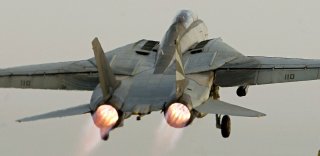Gulf War Heroes: Meet the Bombcats
A jack of all trades to the end.
Key Point to Remember: The Navy would finally retire the 1970s-vintage fighters just three years later. But in its final days, the F-14 was at its peak.
Early in the morning on March 19, 2003, U.S. Special Operations Forces infiltrated western Iraq to neutralize strategic radar and command installations. It was one of the first attacks of the American-led invasion — and it played out under the watchful gaze of a secretive detachment of aging but still very capable U.S. Navy F-14 Tomcat fighters.
Tony Holmes tells the whole amazing story in the September 2015 issue of Combat Aircraft magazine.
The twin-engine, two-seat, swing-wing F-14 was an old airplane in 2003. The Navy would finally retire the 1970s-vintage fighters just three years later. But in its final days, the F-14 was at its peak. The Navy had added sensor pods and GPS- and laser-guided bombs, transforming the Tomcat into the ground-attack Bombcat.
Fast, powerful and flexible with huge fuel capacity, the Bombcat also turned out to be an excellent command platform. In the forward-air-control-airborne — or FAC(A) — role, an F-14 could orbit over the battlefield, its front-seat pilot focusing on flying the plane while the backseat flight officer worked the radar and camera pod.
Radio — and secure datalink in the case of the most advanced F-14D model — allowed the FAC(A) Bombcat to steer other warplanes toward targets on the ground. “Long, dangerous and incredibly important, these FAC(A) sorties required exceptional situational awareness,” Holmes writes.
Shortly before the invasion of Iraq kicked off, a special detachment composed of five F-14As, five two-person crews and 30 maintainers from Navy Fighter Squadron 154 left the aircraft carrier USS Kitty Hawk and set up shop ashore at Al Udeid air base in Qatar, where U.S. Special Operations Forces were also located. The Bombcats’ mission, details of which remain secret 12 years later, was to support these specialized troops.
F-14s almost always flew from carriers, but the commandos demanded to be able to speak face-to-face to the aircrews covering them, so the Bombcats had to operate from land. When the commandos flew into western Iraq under the cover of darkness on March 19, two of the VF-154 F-14s and other jets were overhead.
The Special Operations Forces’ targets were Pluto and Flat Face early-warning radars and a command bunker near Iraq’s border with Jordan. The radars cued air defenses that stood in the way of Jordan-based U.S. warplanes poised to strike Iraq.
The attack was a success. The killing blow came when the F-14s guided Air Force F-15Es as they dropped 5,000-pound bunker-buster bombs to wipe out the underground bunker. Today, VF-154 flies F/A-18F Super Hornets.
David Axe serves as Defense Editor of the National Interest. He is the author of the graphic novels War Fix, War Is Boring, and Machete Squad.
This first appeared in WarIsBoring here in 2018.
Image: Reuters

